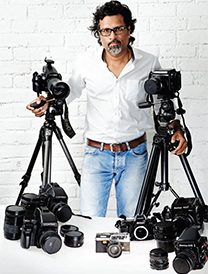My journey in photography started because of my dad’s interest in cameras/photography. But my first serious camera was all thanks to my mom who had got this viewfinder camera from Japan in the 1964 Olympics, called Petri and I still have the camera with me! Dad had a background in photography because he grew up in a famous studio in Nagpur called “Acme studio” and helped his uncle with cameras, developing and printing. He carried this forward to Jamshedpur where he did a lot of black & white and colour photography which had a great influence on me.
Very early in life, when I was around 10 years or so, I got my hands on a Minolta manual book, with a lot of cameras described there and their functions; that got me and my friends interested in photography. When I first shot with the Petri camera, my dad was there to explain the shutter/aperture equation and I distinctly remember an image that I shot of my dog Zico with that first roll of black & white; it was a close up, shot at f/2.8 and it came out brilliant!
Later, when I was in the 7th standard, my dad managed to get a second-hand SLR camera called MIRANDA, which was my first “proper” camera. The meter did not work, so I initially shot with a lot of guess-work and made use of the “sunny day f/16 rule”. Shortly, my brother landed his hands on a manual exposure meter that got the guess-work out of the photography. I used this camera along with a Canon AE1 which belonged to a dear friend, till my 12th standard.
When I came to college in Pune, in addition to the Miranda, I had my uncle’s Yashica FX3 that I was allowed to keep and use. I got many of my best amateur photos with this one including a few which won some contests in the Times of India, Pune edition. This speared me on for doing an evening course in Fergusson College that further got my interest cemented in photography. Final year of college saw me shoot many a “mini portfolio” for my pals; a one roll 4/5 changes shoot and they paid for the roll and printing.
When I finally shifted to Mumbai to pursue my career as an assistant photographer, I got a Nikon 801S with the kit lens and a 70-210mm. I quickly sold both these variable aperture lenses and got myself a 80-200mm f/2.8 ED lens. This kit, along with a Nikon F90, was my bread and butter equipment for all my portfolios and fashion work that I did initially. A couple of months before starting out on my own, I got myself a secondhand Mamiya RB67 kit along with 3 lenses, 2 backs and a Polaroid back . This was in 1998. In 1999, I upgraded to a new kit of Mamiya RZ67 with the same configuration. This camera was my “work horse” and I did most of my initial advertising work with it. Then the 645 format craze started and I got myself a non-auto-focus Mamiya 645 with one telephoto lens. This camera was mostly used for my commercial fashion work as it was light and easy to hand-hold.
In 2003, with the digital age looming, I got myself a Kodak 13.4-megapixel camera with the Nikon lens mount. I used this camera a bit but was not too comfortable with the output, so in six months or so got myself a Contax 645 system with the Phase One 22 megapixel back. This system was my new work horse and along with the Canon 5D Mark 2, was my setup till a few years back. The Contax is one of my favourite cameras till date for its build quality and “feel”.
I am currently running the Phase One camera system with Schneider lenses which has been my ‘go to’ system for the last 5 /6 years. It is equally robust and solid compared to the Contax and is running the 39 megapixel back. My next system will be the Canon 5DS, which, at 50.6 MP, offers file sizes big enough for all jobs and the added advantage of a faster focusing system than the medium formats. With age catching up, the autofocus advantage is a big thumbs-up, plus the maneuverability of the smaller format.
In addition to these systems I have also used the Canon PowerShot G-series, namely the G7 and the G12 for a lot of my holiday and travel work. They are wonderful little cameras to have fun with but today their place is taken by the iphone that gets equally if not better images provided one knows to use it. The digital era has made it easier for more people to shoot and see their pictures immediately but somewhere there is a lack of discipline in the image making; looking through the viewfinder has a different “magical appeal” and I hope that future generations can rediscover some of it. |SP


